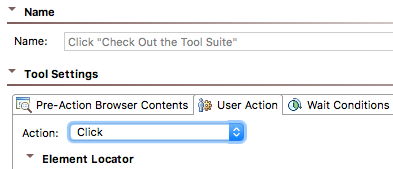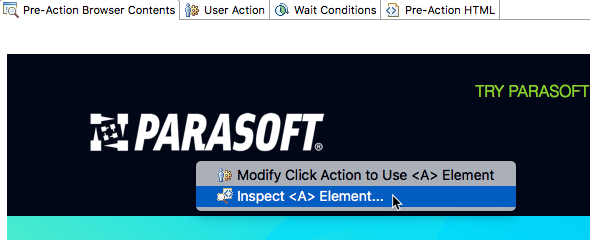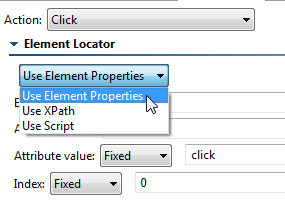This topic explains how to modify the user actions simulated by a web scenario. Sections include: To view and modify the action taken by a specific scenario step: You can use data sources to parameterize user actions. For instance, to have a "type" action iterate through a set of different values stored in an Excel spreadsheet. The element that is the source of a user action will be highlighted with a solid blue border in the scenario step’s Pre-Action Browser Contents tab. To quickly change the target of a user action, right-click the related element in the Pre-Action Browser Contents tab and choose the appropriate Modify command. If the user action that you want to change is not associated with a specific element (for instance, a "close" or "navigate" action), click the User Actions tab and choose a new action from the Action menu to modify the target. As you create and modify user actions for page elements, you may want to inspect the HTML to determine if you are adding actions to the appropriate elements. To see the HTML for an element, right-click the element and choose Inspect <Element>. You can configure most common user actions by selecting from the list of preset actions, then customizing them as needed to suit your needs. The available preset actions are described below. The User Actions tab contains configuration settings for many preset user actions. Choose a user action from the Action menu and configure the element locator settings. See Specifying Specialized Element Locators for more information. The element locator settings allow you to specify the element associated with the action. The following element locator options are available: Specifies the expected value for the attribute supplied by the Attribute Name field. Specifies the element that matches the previous criteria. Entering Many actions allow you to configure Window Name. This allows you to specify the name of the window you would like the action to occur in. Leaving this field blank indicates that the default window will be used.User Actions Configuration Overview
Using Data Sources to Parameterize User Actions
Identifying Elements Associated with User Actions
Changing the Target of a User Action
Inspecting the HTML for Elements
Understanding Preset Actions
User Actions Tab
Element Locator Settings
Element Specifies the element name (for example, "img", "div", or "a") that the action should apply to. To allow any element, enter Any into this field.Attribute Name Specifies the attribute name to identify the element (for example, "title", "id", or "name"). You can configure this value using one of the following mechanisms. Attribute Value Index 0 means that the first element that matches the "Element," "Attribute Name," and "Attribute Value" criteria will be used. Entering 1 means that the second element that matches will be used, and so on.
Overview
Content Tools




